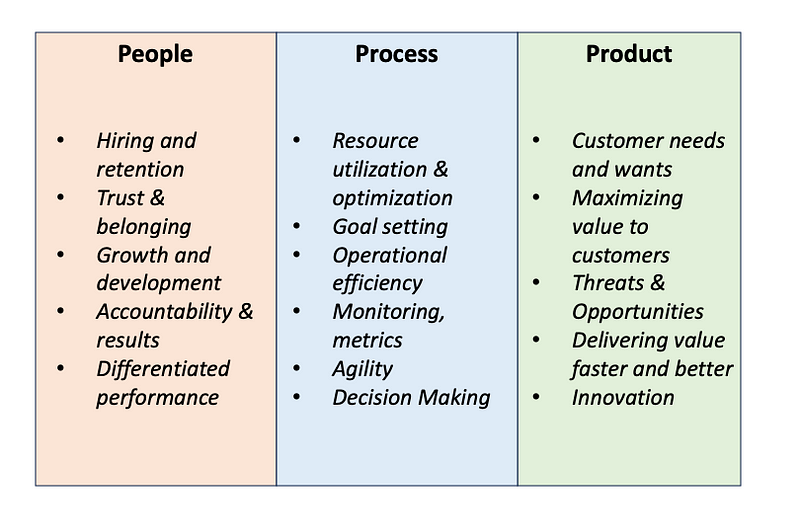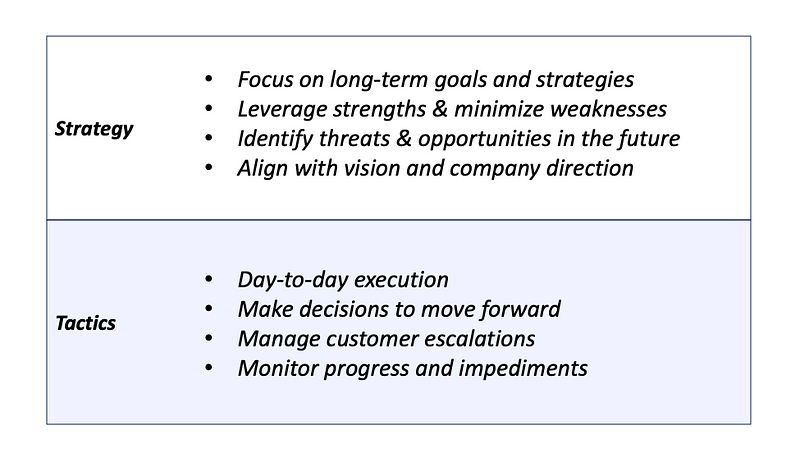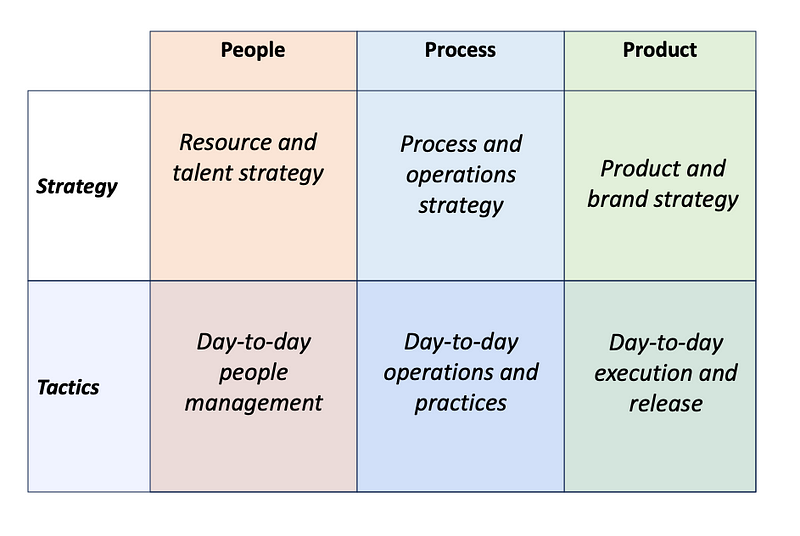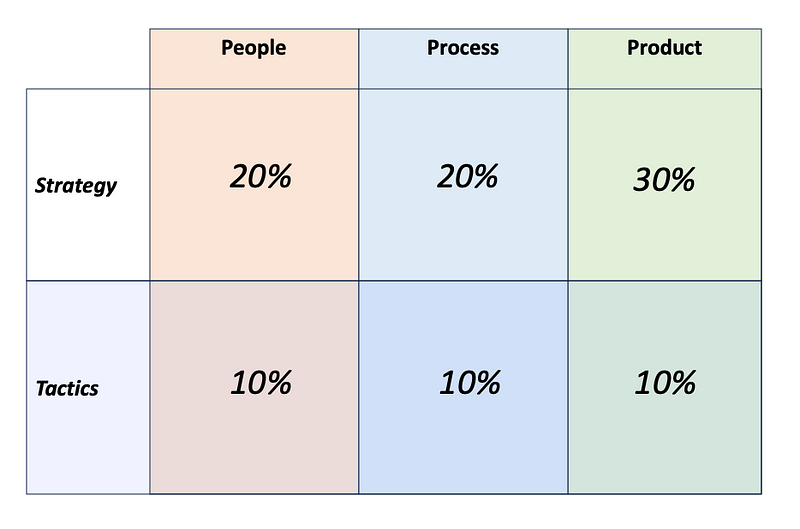Mind Boxing: How Leaders (Should) Spend Their Time (The 6 Box Framework)
How do you “define” the role of a leader? More specifically, how should leaders spend their time?
Leadership is complicated. Every leader is different. They have a unique style, a unique background, and a unique approach.
Add to that the different levels of leadership. You may be a front-line manager, a middle manager, or a senior executive.
With all that added complexity, it can feel daunting for you to go about doing your job, and to prioritize what matters most in your role. In this article, I will lay out a simple framework that you can use to “Mind Box” — i.e., organize and optimize your time to drive maximum value out of your role.
The 3 Verticals of Leadership
Regardless of your role, your division, or your industry, as a leader you need to focus on three over-arching aspects of your role. I call these the ‘3Ps’ of leadership: People, Process, and Product.

People
People form the building blocks of any organization. Without the people, the organization is empty.
“Alone we can do so little, together we can do so much.” — Helen Keller
As a leader you should pay attention to the people that make up your organization, both within and without. You should strive to provide an environment of trust and belonging to your teams, while ensuring that you are deriving maximum value from your organization towards the business goals. Depending on the situation, you may need to put on a variety of hats as you go about working with your people, including coach, mentor, taskmaster, and problem solver.
As a people leader, some of the pertinent questions you should be asking yourself are:
- How can I provide an environment of trust and belonging?
- What factors can help my teams put in their 100%?
- What training and development opportunities can I provide to my teams so they can continue to upskill and grow?
- How can I ensure differentiated performance in my organization, where the highest performers are being rewarded higher and grow faster?
- How can I build a high-performing team?
- How can I hold my teams accountable for their roles and expectations?
Process
If you want to know how an organization functions, look at the processes they have in place. I almost look at processes as the ‘X-Ray image’ that helps you to peek into the inner workings of an organization.
“Efficiency is doing things right; effectiveness is doing the right things.” — Peter Drucker
As a leader, you need to play with the two levers — efficiency and effectiveness. You need to ensure that your operations are optimal, that you are using the right resources for the right job, and reducing wastage. At the time same, you need to ensure your teams are heading in the right direction, and that they have their goals defined. You need to help them to prioritize and refine as they march forward. There are multiple paths you can lead your team towards your business goals, and it is your job to help them find one that is optimal.
Some of the pertinent questions you should be asking yourself:
- Am I utilizing my resources in the most optimal way (resources include human, capital, cash, time, etc.)
- Does my team know what they need to accomplish, and what will drive the maximum value for our business?
- Are there roadblocks and red tape that might be coming in the way of efficient execution for the teams?
- Do we have the necessary automation in place to maximize efficiency?
- Do we have mechanisms to monitor our efficiency and performance through KPIs, metrics, and dashboards?
- How can we make decisions efficiently to move forward faster and with greater impact?
Product
As a business, your ultimate goal is to build and deliver a product, platform, or service to potential customers. I will use the term ‘product’ here more broadly to refer to any of those.
“Your brand is formed primarily, not by what your company says about itself, but what the company does.” — Jeff Bezoz
As a leader, you should always be thinking about how you can build the best product possible, a product that is going to solve a real need. You need to be tuned in to your customers or potential customers, what their needs and wants are, and continue to innovate. You need to stay informed about the opportunities, the threats, and your competition.
Here are some questions you should be asking yourself:
- Who are our primary customers?
- What are their needs and wants?
- How can we provide the value that our customers are looking for?
- How can we measure success in meeting those needs?
- How can we beat the competition, and be a leader in the market?
- How can we provide the best experience for our customers?
- How can we grow and retain our loyal customer base?
- How can we deliver value faster, and better?
- How can we innovate and be ahead of the competition?
The 2 Layers of Leadership
Now that we reviewed the 3Ps — or the three verticals — of leadership, let’s turn our attention to the two (horizontal) layers of leadership. Every leader has a specific role in their organization, and they are at a certain level in the hierarchy. The level determines their scope of work, their influence, and their overall impact on the organization.
Broadly speaking, every leader operates in two “layers”, and the time they spend in each layer is correlated to their level in the organization: Tactics, and Strategy.

Strategy
This is by far the weakest point for most leaders I have met. Many leaders tend to get trapped in the day-to-day tactics, and do not pay enough attention to the strategic contributions they can make as leaders.
As a leader, you should always be looking ahead, and thinking strategically about where you want to take your organization. You need to look at the long-term goals, measure your team’s strengths and weaknesses, and keep a close eye on the opportunities and threats you need to prepare for. You need to ensure your team has a roadmap and a path forward, and your decisions should always be driven with the long-term approach in mind. This is especially true as you grow into more senior leadership roles.
Some of the key questions you need to ask yourself as a strategic leader are:
- What is the resource strategy for my organization? What is the location strategy?
- What skillsets am I missing, or need to build over the next few years?
- What roadmap should we be building for the coming years?
- How can we improve the overall efficiency of our organization in the long run? What steps can we take now and in the medium term?
- How can we build on our team’s strengths, and reduce the gaps on the weaknesses over the next year?
- What innovation or new experiments can we run today that can help us be better prepared for future advances in technology and customer behavior?
- What steps can we take in the immediate to medium-term to help us reach our long-term organization goals?
Tactics
Fundamentally, your job as a leader is to get the job done. No matter how smart you are, and how innovative your organization is, if you are not able to deliver the results then you are not performing your job.
Tactics is about the current, and the day-to-day execution. This is your bottom line. You need to ensure you are delivering against the goals that you had set for yourself and your teams. In particular, front-line and junior managers spend the majority of their time doing just this.
But this is not just limited to front-line managers. As a leader, you need to be aware of the situation, the stresses, and the bottlenecks your teams may be facing in getting the job done. You need to step in from time to time to help unblock them, to provide direction, and to help them succeed. You cannot keep a blind eye towards what’s happening, and expect everything to function flawlessly.
Some of the key questions you should be asking yourself as a tactical leader are:
- What are the current top priorities that I need to focus on today?
- Are there customer escalations that need my attention?
- Are there decisions that I can take today to unblock the team or my stakeholders?
- What information do I need today from the team, and where can I find it?
- What information do I need to share with my team today that will help them with their tasks?
- Which dashboards do I need to review today to track our business KPIs, metrics, and system performance?
- Are there team conflicts or situations that need my attention today?
Putting it together: The 6-box Framework
Leadership is complicated. You usually find yourself in situations that you may not have anticipated, and you need to think on your feet and make decisions to unblock your organization.

In this article I discussed a 6-box framework, what I call “Mind Boxing”, that any leader can adopt to put some structure around their role. This can help you to be more intentional about how you spend your time, and derive the maximum value out of your time spent.
The 3 verticals are:
- People: ensuring the well-being of the people you lead, the stakeholders you manage, while holding them accountable to their roles
- Process: ensuring your organization is both efficient and effective in “how” they get work done
- Product: ensuring you are building the best product/platform or service that will delight your customers, and help you to drive the business results of your organization
The 2 layers are:
- Tactics: ensuring that you are delivering results, and getting the job done. You are aware of and helping your team handle day-to-day situations, escalations, and decisions
- Strategy: ensuring that you are thinking long-term, and are intentional in how you steer your organization forward towards the long-term business goals
Applying the Mind Box
Here is how you can use the mind box and apply it to your leadership role:
- First, decide how you want to allocate your time between the 6 boxes. You should use your goals and priorities to aid with this allocation. You can even work with your manager to help you figure out where you should be spending your time in your role. For instance, you may decide to allocate 70% of your time on the Strategy layer and 30% on Tactics. Within each layer, you should allocate time between the 3P verticals (People, Process, Product).

- Second, review your calendar, your TODO lists, and your priorities for the coming week or month, and align those with your time allocation. I like to color code my meetings in Outlook to indicate which box they belong in, and when I look at my weekly calendar I can visually see where my time is going.
- Finally, review your allocation on a regular basis. Priorities may change over time as your role evolves, or the business needs change. There is no right allocation for everyone, but the key is to be intentional about how you are spending your time, and that you review/assess it regularly.
Like my writing?
I would love to hear your thoughts and suggestions in the comments below.
If you found this post valuable, consider giving me a follow and some claps👏 as a form of encouragement.
You can also connect with me on LinkedIn or X, and learn more about me here. Note that the views and ideas expressed in this post are purely mine, and not affiliated with any organization or group. Thank you!






